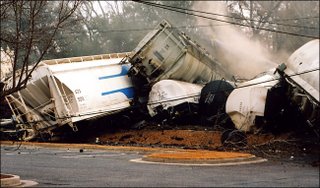 In an article in the October issue of Homeland Protection Professional (no link, paid subscription), Technology Writer Douglas Page discusses the January 6, 2005, train derailment in Graniteville, SC. The train was carrying deadly chlorine gas, sodium hydroxide and creosol. One chlorine car ruptured, spewing 90 tons of gas into the atmosphere. Nine died, hundreds were injured, and more than 5000 people were evacuated (many could not return home for two weeks). Page notes that approximately 13 million tons of chlorine was produced in 2004, with most of it shipped by rail.
In an article in the October issue of Homeland Protection Professional (no link, paid subscription), Technology Writer Douglas Page discusses the January 6, 2005, train derailment in Graniteville, SC. The train was carrying deadly chlorine gas, sodium hydroxide and creosol. One chlorine car ruptured, spewing 90 tons of gas into the atmosphere. Nine died, hundreds were injured, and more than 5000 people were evacuated (many could not return home for two weeks). Page notes that approximately 13 million tons of chlorine was produced in 2004, with most of it shipped by rail.What does a tragic rail accident have to do with Weapons of Mass Destruction?
What if, instead of derailing in a small South Carolina town at 2:40am, the train had derailed at 3:30pm? What if it happened in Washington, DC, where tracks run less than five blocks from the US Capitol and the National Mall? In the autumn, with the Mall crowded with tourists?
What could happen is this:
- 100,000 people could be killed or injured in the first 30 minutes.
- People could die at the rate of 100 per SECOND.
- A cloud of toxic gas 10 miles wide and 40 miles long could be produced
You think maybe a terrorist might consider that scenario worth considering? Remember, fewer than 3,000 died in NYC on 9-11.
I've been bitching about chemical security for a while. Back in August, I wrote:
Force the chemical and energy industries off their collective asses and start making some serious progress in securing their respective facilities. [snip] Chemical security is a joke: recent articles in the NY Times, for instance, showed open, unmanned gates into freight yards handling hazardous loads.
I'm not the only one, of course. Just about every safety and security person outside of DHS has been screaming about how tempting these targets would be.
The Emergency Response Guide, a cooperative effort of the US Dept of Transportation, Mexico's Secretariat of Transport and Communications, and Canada's Transport Canada, indicates a minimum exclusion area of 100 meters (330 feet) in all directions for most unknown spills. If the spill involves a tank, rail car, or tank truck, the minimum is 800 meters (1/2 mile). The Graniteville chlorine leak required an exclusion zone of one mile.
Just for the hell of it, here are some minimum evacuation distances from the ERG:
- Chlorine: 0.8 mile
- Phosgene: 2.6 miles (phosgene is an ingredient in methyl isocyanate)
- Cyanogen chloride: 1.5 miles
- Pentaborane: 2.1 miles
- Liquified gas, flammable, poisonous: 3.2 miles
How close are you to a rail line?
The Department of Homeland Security, of course, is still too busy planning for the last attack to worry about the next attack. The chemical industry sure isn't going to volunteer to implement security procedures on their own: keeping things safe costs money, which could otherwise be put to "better" uses... like stock options, dividends, and executive pay packages.
The industry doesn't even really learn from its own mistakes, either: after Bhopal, Union Carbide did the absolute bare minimum in upgrades in its West Virginia plant (which produced the same methyl isocyanate as the Bhopal plant). Then they sold off the Indian subsidiary that ran the Bhopal plant, claiming that the management in Bhopal had not followed corporate guidelines. [Note: for a really in-depth look at how Union Carbide botched Bhopal, as well as detailed discussions of the Three Mile Island disaster, and two well-handled crises -- Rely tampons and the Tylenol poisonings -- see Steven Fink's Crisis Management: Planning for the Inevitable.)
And Lord knows we can't rely on the Bush administration to protect us. The current crop of politicians (at least until January) is too deep in the pockets of their corporate sponsors to do anything that would reduce profits. Why do you think the Feds are so enamoured of duct tape?
The problems aren't restricted to chlorine, either. There are plenty of other hazardous materials running around the country: anhydrous ammonia (used in commercial cooling systems), propane, gasoline, fuel oil. In fact, the ERG has 70 pages of listings by chemical name... in about 6-point type (about 50 listings per page, or roughly 3500 altogether).
One in six trucks carries some sort of hazardous material.
Okay, this piece isn't going to give you the "warm fuzzies". It's not supposed to. It's supposed to wake you up so you can lean on your Congresscritters to improve our security.

You have to remember that the office of Homeland Insecurity isn't looking at possible train derailments or transport trucks exploding. They're looking for the Hollywood version of nuclear bombs detonating and planes flying into buildings (oh wait,done that, scratch that one). And if they can't find those scenarios then they'll be just as content watching you and what you do.
ReplyDelete